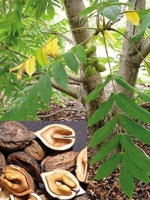In the right wing of the main building NTUU "KPI", which housed its administrative services, a luxurious tree spreads its branches, from which it is impossible to tear admiring glances during the summer and winter. Its crown woven from horny branches decorated with sufficiently large pinnate leaves. This is the Manchurian walnut (Juglans mandshurica Maxim).
In the wild it densely covers the territory of North China, is distributed in Manchuria, Primorski and Khabarovsk Region, Sakhalin and the Kuril Islands. This tree reaches 20-27 m in height and up to a meter in diameter. Life expectancy is up to 200 years. Walnut grows in river valleys, on the slopes of the mountains, settling on fertile soils. It grows singly or in groups of trees.
It is difficult to name another tree, which would combine so many useful properties. Its lightweight, durable and beautiful light brown wood is especially appreciated. It is used to the best grades of plywood and veneer, the liner panels, the production of furniture and parts of musical instruments. Roots of walnut used for artistic works, the exquisite drawers and butts for expensive hunting rifles - the hunter's dream!
Tannins are obtained from the bark, leaves and juicy fruits walnut shells (in the crust there are about 14%, and in fruit shells - up to 22% of them). The stable dark brown paint is obtained also for furniture of cedar, birch and other wood before the white lacquering. From hard-shell nuts one can prepare ink and black ink. And by spraying thin plate, get a great delicate material for the manufacture of jewelry and various household trifles.
 Kernels in taste is not inferior walnut and contain more than 55% of the feed oil. But, unfortunately, thick and rough peel, which is about 82% by weight of the nut reduces their nutritional value. Manchu nuts can be eaten raw and are used to make halva. With a single tree in the age of twenty five in the crop year you can collect up to 30-40 kg of nuts, peeled from outer fleshy shells. The good harvests occurred in two or three years. The spring’s stream of juice is powerful and sugar content reaches three percent. But the collection of the juice in unreasonable, because it weakens the productivity of the tree.
Kernels in taste is not inferior walnut and contain more than 55% of the feed oil. But, unfortunately, thick and rough peel, which is about 82% by weight of the nut reduces their nutritional value. Manchu nuts can be eaten raw and are used to make halva. With a single tree in the age of twenty five in the crop year you can collect up to 30-40 kg of nuts, peeled from outer fleshy shells. The good harvests occurred in two or three years. The spring’s stream of juice is powerful and sugar content reaches three percent. But the collection of the juice in unreasonable, because it weakens the productivity of the tree.
Nuts belong to the plants which actively emit phytoncides. On a hot day, stopping under a tree, you can feel the specific aroma that resembles the smell of rotting grass with pine "note". Dry leaves of walnut are used for storage of fur and woolen products from moths. Tinctures and extracts from young leaves are known in folk medicine as drugs.
Such is a visitor which for many decades decorates the territory of our university.

